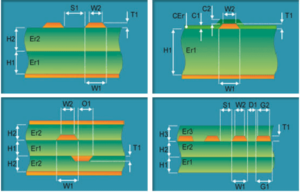Impedance Control PCBs
Expertise in PCB Manufacturing
Specializing in advanced materials like Ultra Low Loss FR4, Ceramic Filled, PTFE Reinforced, Teflon, Hydrocarbon, Arlon, Rogers, AGC (Nelco/Taconic), Isola, Panasonic, Shengyi, TUC, and Ventec.
Offering hybrid solutions such as PTFE+FR4 and Ceramic+FR4 combinations to meet diverse technical requirements.
Providing precision-controlled impedance down to 5%, along with advanced features like Blind & Buried Vias, Micro Vias, and HDI technologies.
Utilizing both Conductive and Non-Conductive Via Plugging for enhanced reliability and performance.
Certified to the highest industry standards with ISO9001:2015 and UL listings, ensuring top-quality PCB production.
Benefits of Impedance Control PCBs
Enhanced Signal Bandwidth and Integrity
Impedance Control PCBs are engineered to support higher signal bandwidth, ensuring superior signal integrity for advanced electronic applications.Optimized for High-Speed Signals
These PCBs effectively reduce crosstalk, making them ideal for high-speed signal transmission and enhancing overall performance.Efficient EMI/RFI Reduction
Impedance-controlled boards are more effective at minimizing electromagnetic interference (EMI) and radio-frequency interference (RFI) compared to standard boards.Elimination of Signal Reflections
Designed to match impedances across the circuit, these PCBs eliminate reflections, ensuring accurate and reliable signal transmission.
Request Your Free Quote Today!
Understanding Impedance Control PCB
Before diving into impedance control PCBs, it’s essential to grasp what impedance control means.
In a circuit board, various signals are transmitted through conductors. As the demand for faster transmission speeds and higher frequencies increases, factors like etching, lamination thickness, and wire width can alter the impedance values, leading to signal distortion. To maintain signal integrity, the impedance of conductors on high-speed circuit boards must be carefully controlled within a specific range, a practice known as “impedance control.”
An impedance-controlled PCB is precisely engineered to manage electrical impedance, ensuring accurate signal transmission between components. These PCBs are designed to minimize power consumption, prevent signal loss due to reflections or interference, and offer a cost-effective solution for complex electronic systems. By maintaining controlled impedance, these PCBs play a crucial role in ensuring reliable and efficient data transmission in advanced electronics.
Types of Impedance Control
Single-Ended Impedance Control
Single-ended impedance involves controlling the impedance of a single wire or trace. Key factors influencing this type include trace width and length, copper thickness, PCB material thickness, dielectric constant (Er), solder mask properties, and solder mask thickness.
Differential Impedance Control
Differential impedance is achieved by managing a pair of wires or traces, typically with identical widths separated by a precise gap. This control is influenced by the width and length of the traces, the spacing between them, copper thickness, dielectric thickness, and the dielectric constant (Er) of the circuit board and solder mask.Coplanar Impedance Control
Coplanar impedance involves controlling the impedance of PCB traces situated between ground (GND) and power (VCC) layers. These traces are shielded by adjacent layers of copper. The impedance value here is determined by factors such as trace width and length, copper thickness, dielectric thickness between the GND/VCC layers, and the dielectric constant (Er).
Understanding Characteristic Impedance
In PCB signal transmission, signals function based on both time and distance, causing variations across different sections of the circuit. To design an effective impedance PCB, it is crucial to determine the AC impedance, known as characteristic impedance. This impedance is the ratio of voltage change to current change in a transmission line, and it is influenced solely by the characteristics of the signal wiring itself.
In practical controlled impedance PCBs, the electrical resistance of the connecting wire is typically lower than the system’s distributed impedance, particularly in high-frequency circuits. As a result, characteristic impedance is primarily determined by the unit-distributed capacitance and unit-distributed inductance along the connecting wire.
Characteristic impedance is essential in high-speed signal transmission, as it ensures that the electrical performance of the PCB prevents signal reflection, maintains signal integrity, reduces transmission loss, and facilitates proper matching. This results in complete, reliable, and interference-free signal transmission.
It’s important to note that impedance should not be considered better simply because it is higher or lower; the key is achieving proper matching. Typically, impedance is necessary only for high-speed PCBs, where trace width tolerance must be controlled within 5%-10%. In contrast, other trace widths do not require impedance control and can have a tolerance of 20%. Achieving precise impedance control is challenging, but LEAPPCB excels in producing all types of controlled impedance PCBs with high accuracy.
Selecting the Right Stack-up for Impedance Control PCBs
Choosing the appropriate stack-up is crucial for achieving accurate impedance control in PCBs. The stack-up, or the arrangement of different layers on a PCB, significantly impacts how well impedance is managed. Selecting the correct stack-up ensures that the impedance control is both effective and reliable.
The most common stack-ups for impedance control are 6-layer and 8-layer configurations. A 6-layer stack-up usually provides sufficient impedance control, but for cases where the impedance exceeds 25 ohms or where high signal speeds are required, an 8-layer stack-up is recommended.
To maintain precise impedance control, each layer in the stack-up must be carefully selected. Typically, the first two layers consist of signal and ground planes, followed by four dielectric layers that serve as the impedance control components. The final two layers usually consist of power and ground planes.
In addition to careful layer selection, it’s essential to choose materials with appropriate impedance values and to account for the impedance tolerance of the stack-up. By paying attention to these factors during the design process, you can achieve a highly reliable controlled impedance PCB.
Key Factors Influencing Impedance Control
Dielectric Thickness
- For double-layer PCBs, this refers to the thickness of the FR4 base material. In multi-layer PCBs, it involves the thickness of the prepreg (PP) and core layers.
Trace Width and Spacing
- The width of the traces and the gap between them are critical factors that directly impact the impedance value.
Copper Thickness
- This refers to the final thickness of the copper, typically around 1 oz. Inadequate copper thickness can significantly affect the impedance.
Dielectric Constant
- This pertains to the dielectric constant of both the solder mask and the dielectric layers. Variations in these constants can alter the impedance.
Solder Mask Thickness
- While solder mask thickness has a minimal effect on impedance, an increase of 10 µm in solder mask thickness can cause a minor change in impedance, typically by 1-2 ohms.
Essential Information to Provide for Impedance Control PCB Manufacturing
Identify Impedance-Controlled Traces:
- Clearly mark the traces that require impedance control in the PCB design. This can be communicated through detailed documentation or annotated images.
Impedance Calculation and Lamination Details:
- Provide the calculated impedance values, along with the specified trace width and spacing for each layer of the PCB. This information is crucial for the manufacturer to maintain strict control during production and ensure the final product meets the desired impedance specifications.
Impedance Test Requirements:
- If you wish to independently verify impedance, request the inclusion of an impedance test bar in your PCB design. This test bar allows for direct impedance testing using an impedance tester. If you are experienced with impedance testing, you can design the test bar in available space on the PCB, allowing for easy validation of the controlled impedance post-production.
Why Choose LEAPPCB as Your Impedance Control PCB Supplier?
Affordable, High-Quality Impedance Control PCBs
LEAPPCB employs strategic cost-reduction methods to deliver top-notch impedance control PCBs at competitive prices, ensuring you get the best value without compromising quality.Precision in Every Detail
LEAPPCB leverages cutting-edge manufacturing processes to produce high-precision impedance control PCBs, guaranteeing exceptional reliability and stability for your electronic devices.Expertise You Can Trust
At LEAPPCB, our team of highly skilled technicians and engineers specializes in advanced PCB fabrication techniques. Their expertise allows us to offer you reliable, cost-effective, and efficient impedance control PCBs tailored to your specific needs.
Get Your Free Instant Quote Today!
Leap Electronic is your trusted partner and one-stop shop for PCB fabrication, component sourcing, PCB assembly, and electronic manufacturing. With over 16 years of expertise, we proudly serve over 1000 customers worldwide, delivering top-quality PCBs at competitive prices. Our ISO9001:2015 certification and UL listing ensure that all our products meet the highest industry standards. Every PCB is 100% E-tested and inspected using AOI and X-RAY, guaranteeing unparalleled reliability and performance.
Don’t wait – get an instant quote from our sales team today and experience the Leap Electronic difference. We’ll handle the rest!
Applications and Considerations for Impedance Control PCBs
Impedance Control PCBs are essential in high-speed and high-frequency applications such as communication systems, radar systems, hard disk drives, RFID systems, and various advanced digital electronics.
Yes, Impedance Control PCBs typically come at a higher cost compared to traditional FR-4 boards due to their specialized design and manufacturing processes.
During the engineering and production phase, we incorporate test bars on each panel of the circuit board. These test bars contain the impedance traces, allowing us to accurately measure and verify the impedance values on the controlled impedance PCB.
The lead time for manufacturing Impedance Control PCBs is generally similar to that of standard PCBs. However, the exact timeframe depends on factors like project complexity, the number of layers, and the materials used.
The cost of Impedance Control PCBs is influenced by the design complexity, materials, board size, layer count, production quantity, and the manufacturing technology employed.
Absolutely, LEAPPCB can produce controlled impedance PCBs with a precision tolerance as tight as 3%.
